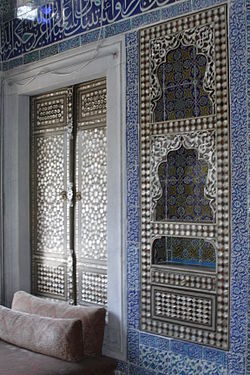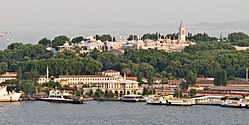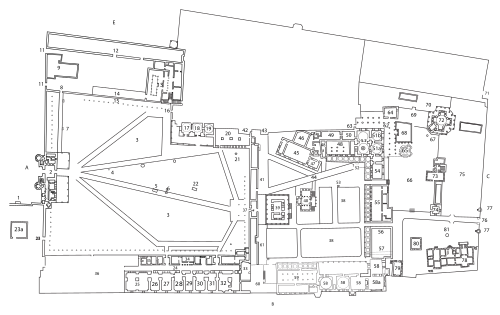Topkapı Palace
The Topkapı Palace (Ottoman طوپقپو سرايى Topkapı Sarayı, German 'Kanonentor-Palast') in Istanbul, in German also Topkapi Palace or Topkapi Serail, was for centuries the residence and seat of government of the sultans as well as the administrative centre of the Ottoman Empire.
Construction began soon after the conquest of Constantinople (1453) by Sultan Mehmed II. At first, he had a palace built on what is now Beyazıt Square (Beyazıt Meydanı). A little later, however, he decided to build a second project elsewhere. Beginning in 1459, a new palace, initially consisting of two courtyards (now the 2nd and 3rd courtyards), was built on what is now called Sarayburnu, between the Golden Horn and the Sea of Marmara, and was completed in 1468. In the process, parts of the Byzantine Mangana Palace were built over. In 1478, a defensive wall was completed at a distance around the palace, which, among other things, formed the space for today's first courtyard. Thus, the basic structure of the palace was already established in its essential features in the 15th century. Even after the later alterations, the building is still one of the most important architectural testimonies of the Renaissance period in Europe.
The complex acquired its present appearance through extensive renovations and extensions up to the beginning of the 18th century. The last major addition was the Great Pavilion (Mecidiye Köşkü), built in 1840 by the Armenian architect Sarkis Balyan. Since Mehmed II, all Ottoman rulers resided in the Topkapı Palace until Sultan Abdülmecid I moved into the new Dolmabahçe Sarayı on the other side of the Golden Horn on the shore of the Bosphorus in 1856. Both palaces are museums today.
The palace does not consist of a single building but, true to Turkish tradition, several buildings in a large garden. With an area of over 69 hectares and up to 5000 inhabitants, the palace was a city in its own right. It was initially called Saray-ı Cedîd-i Âmire / سرای جديد عامره or Yeni Saray / يکی سرای / 'New Palace', before the name Topkapı Sarayı prevailed in the 18th century, derived from the palace's own cannon foundry.
The palace is divided into four courtyards, each accessed through its own gates. With its location on a headland, it offers an unparalleled panoramic view of Istanbul, the Bosphorus and the Golden Horn.

Mother of pearl inlays and tiles in Baghdad kiosk

The hall with fountain in the harem
.JPG)
Model of the whole complex in the 17th and 18th centuries.

View of the palace from the Golden Horn

Topkapı, entrance gate
Overview

First Court
The main entrance to the palace grounds is the Bâb-ı Hümâyûn / باب همايون / 'grand lordly gate'. To the left and right of the gate are rooms that were intended for the guards. Above the archway, there is a calligraphic inscription of Ali bin Yahya Sofî, which bears the date 1478, and thus was made during the reign of Mehmed II. The first courtyard mainly housed premises for services. Parades were held in the park-like square.
Questions and Answers
Q: What is the Topkapı Palace?
A: The Topkapı Palace is a palace located in Istanbul, Turkey.
Q: What does Topkapı Sarayı mean in Turkish?
A: Topkapı Sarayı means "Cannongate Palace" in Turkish.
Q: When was Topkapı Palace built?
A: Topkapı Palace was built in 1465.
Q: What was the function of Topkapı Palace?
A: Topkapı Palace served as the administrative center of the Ottoman Empire.
Q: Who requested that Topkapı Palace be turned into a museum?
A: Mustafa Kemal Atatürk, Turkey's first President, requested that Topkapı Palace be turned into a museum.
Q: Where was Topkapı Palace built?
A: Topkapı Palace was built on the acropolis, the site of the first settlement in Istanbul.
Q: What is the area and location of Topkapı Palace?
A: Topkapı Palace has an area of 700,000 sq. m and is located at the tip of the historical peninsula in Istanbul.
Search within the encyclopedia